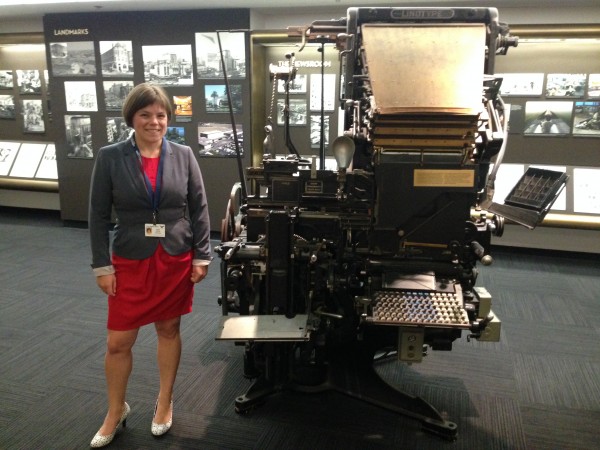8 October 2014
Scientists and Reporters Just Want to Get to the Bottom of It All
Posted by mcadams

Julia Rosen, AGU’s 2014 Mass Media Fellow, who has a Ph.D. in paleoclimatology, stands next to an old newspaper production machine at the Los Angeles Times, where she spent the summer working as a science reporter. Photo by Dione Rossiter, AAAS.
By Julia Rosen
After just a few short months, my desk at the Los Angeles Times had succumbed to the same peculiar malady as my desk at Oregon State University, where I did my Ph.D. in paleoclimatology: It seemed to have sprouted a thin coat of fluorescent sticky notes. Each tiny square bore a fact that merited remembering or a question that demanded answering, and, every day, they multiplied.
As I worked, I arranged and rearranged the notes in various geometric patterns. I was trying to pin down the shadowy form emerging from the fog of information in my head: how the cryptic fragments fit together. How they made a story. What the story said.
This, I learned over the summer, is reporting. Not translating a study for lay audiences—itself a fine and worthy task—but striking out into new territory with a question in mind or an untold story to tell.
This past summer, AGU sponsored me as an American Association for the Advancement of Science Mass Media Fellow at the LA Times. Each year, the program places a dozen science undergraduate and graduate students at various media outlets around the country. During our tenure, we Fellows hone our ability to communicate with the public, and our hosts get an in-house scientist who serves as a temporary staff writer.
At the LA Times, I enjoyed covering new studies as they came out in peer-reviewed journals. But I found the most invigorating and rewarding projects to be those that did not stem from a single scientific paper. Instead, they were attempts to answer timely questions without obvious or simple answers.
For example, during the debate over whether the Food and Drug Administration should ban wooden shelves for aging artisanal cheese due to safety concerns, I wrote a story about the cheese microbiome and how helpful and harmful bacteria interact. Later, I wrote a piece examining the riddle of expanding Antarctic sea ice in the greater context of climate change.
Different people approach the task of collecting and organizing information in different ways, but the purpose is always the same: to share what you find in a way that feels compelling and logical to readers. It sounds simple, but I found it maddeningly—yet also delightfully—challenging.
That’s because to do this well and be true to the facts, you have to talk to as many sources as you can and synthesize their diverse perspectives. You have to sift through the stories they tell you to find the details that pertain to your question and that help build the scaffolding of its answer. You have to identify the places where the evidence is solid and abundant, and pounce on the places where it is not. You have to interrogate your own assumptions and seek out holes in your logic.
Sound familiar? To me, it felt surprisingly similar to the process of doing scientific research.
The fellowship flew by in a blur of interviews, edits, and page after page of frantically churned-out copy. But what I realized in the end is that science and journalism are really both interested in the same thing: the truth.
How we go about finding it may differ—geologists go to the field, journalists to the phone—but in many ways, they are parallel journeys of discovery. Science and journalism both require clearly articulating a question and resisting the temptation to fall down deep rabbit holes of digression. Both require diving into the gory details but not losing sight of the larger point.
While scientists and journalists may sometimes feel like they inhabit different worlds, I think there is plenty of shared ground. Both professions, ultimately, just want to get to the bottom of it all.
— Julia Rosen is AGU’s 2014 Mass Media Fellow. She is spent her 10-week fellowship at the Los Angeles Times and is currently working as a freelance journalist. Rosen earned her Ph.D. in geology from Oregon State University earlier this year. Click here to read Julia’s stories from the Times’ newsroom.
This story also appeared in the 7 Oct. 2014 issue of Eos.


 The Plainspoken Scientist is the science communication blog of AGU’s Sharing Science program. With this blog, we wish to showcase creative and effective science communication via multiple mediums and modes.
The Plainspoken Scientist is the science communication blog of AGU’s Sharing Science program. With this blog, we wish to showcase creative and effective science communication via multiple mediums and modes.
The paleo “newspaper production machine” in the photo is a Linotype, which reproduced a reporter’s typed story in lead letters. A working model can be found in Baltimore’s science and technology museum.